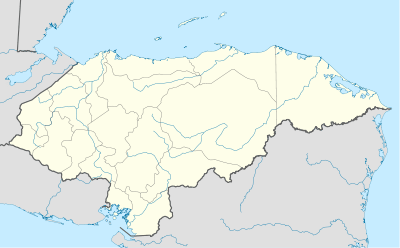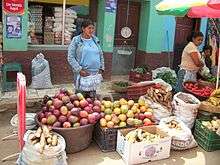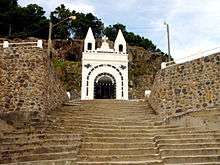La Esperanza, Honduras
| La Esperanza | |
|---|---|
| Nickname(s): La Esperansita | |
 La Esperanza Location of La Esperanza in Honduras | |
| Coordinates: 14°18′23.90″N 88°10′43.21″W / 14.3066389°N 88.1786694°W | |
| Country |
|
| Department | Intibucá |
| Founded | 22 September 1848 |
| City | 1883 |
| Government | |
| • Type | Democratic Municipality |
| • Mayor of La Esperanza | Miguel Antonio Fajardo Mejía (PNH)[1] |
| • Mayor of Intibucá | Javier Eusebio Martínez Ramos (PNH)[1] |
| Area | |
| • Total | 157 km2 (61 sq mi) |
| Elevation | 1,700 m (5,600 ft) |
| Population (2015) | |
| • Total | 12,502 |
| • Density | 80/km2 (210/sq mi) |
| Time zone | Central America (UTC-6) |
| Website | http://www.intibucalaesperanza.hn/ |
La Esperanza (Spanish pronunciation: [la espeˈɾansa]) is the capital city and a municipality of the same name of the department of Intibucá, Honduras. The city of La Esperanza is merged indistinguishably with the city of Intibucá, the head of the neighbouring municipality of Intibucá. Intibucá is the older of the two cities and was originally a Lenca community, while La Esperanza is the newer ladino community.[2] The two cities, often called the twin cities, while distinct with separate municipal governments, are generally referred to jointly as La Esperanza and are separated only by a street that crosses town. La Esperanza is famous for having the coolest climate in Honduras and also for being the heart of the Ruta Lenca, a region of Lenca ethnic influence that spans Honduras from Santa Rosa de Copan to Choluteca.
History
The area was originally occupied by Maya and Lenca people from pre-Columbian times who formed two settlements called Eramani and Lentercala. In 1647, Mayor Francisco de La Cerda was appointed by the Spanish throne to officially demarcate the territory of the indigenous population. He divided the land into two jurisdictions, not corresponding to the Eramani and Lentercala sites, and created boundaries and names for the surrounding small communities. Over time, the two jurisdictions developed a rivalry, especially over land. The cities grew in population especially in the 1800s and La Esperanza was named a villa on 22 September 1848. La Esperanza officially became a city in 1883 when the department of Intibucá was formed by separating from the neighbouring department of Lempira, then called Gracias.[3]
In 2002, permits were obtained by the Consorcio de Inversiones SA de CV (CISA) to build a hydro electric dam on the Rio Intibucá over an abandoned hydro project. Called the La Esperanza Hydro Project after the city, the dam began producing electricity for the surrounding communities in 2003, but its phase two expansion was not completed until 2006. The project was the first in the world to generate Certified Emission Reductions (CERs) under the Clean Development Mechanism (CDM).[4]
Geography

La Esperanza sits at an altitude of 1700 meters, making it the highest city in Honduras. It is bisected by the Rio Intibucá which runs from the municipality of Intibucá through the municipality of La Esperanza. La Esperanza is situated in a relatively flat mountain valley, bordered by two chains of mountains, the Sierra de Puca Opalaca to the north and Montaña Zapochoco to the Southeast. The area of the La Esperanza municipality is 138.8 km2 and Intibucá 531 km2.[3][5]
La Esperanza Airport runs along the valley 2 kilometres (1.2 mi) south of the two cities.
Climate
La Esperanza experiences two distinct seasons: the rainy season/winter from May to October and the dry season/summer from November to April. The rainiest months are June and September, and the driest months February and March. During the winter, it rains primarily in the afternoon and the intense showers often make small dirt roads into the surrounding mountain communities impassable. La Esperanza receives average annual precipitation of 1400 mm. Due to its high altitude, La Esperanza has a cooler climate than most of Honduras, with an average annual temperature of 18.6 °C (65.5 °F). Temperatures in December and January often fall into the 40s at night. Hail has been reported on occasion, but it has never snowed. In the summer, high temperatures reach the 80s, but with low average humidity around 76%.[3][5]
| Climate data for La Esperanza | |||||||||||||
|---|---|---|---|---|---|---|---|---|---|---|---|---|---|
| Month | Jan | Feb | Mar | Apr | May | Jun | Jul | Aug | Sep | Oct | Nov | Dec | Year |
| Average high °C (°F) | 20 (68) |
23 (73) |
25 (77) |
24 (75) |
23 (73) |
23 (73) |
23 (73) |
23 (73) |
22 (72) |
21 (70) |
20 (68) |
19 (66) |
22 (72) |
| Average low °C (°F) | 11 (52) |
12 (54) |
12 (54) |
15 (59) |
16 (61) |
16 (61) |
15 (59) |
15 (59) |
15 (59) |
14 (57) |
12 (54) |
11 (52) |
14 (57) |
| Source: wunderground.com;[6] | |||||||||||||
Population
La Esperanza has an estimated population of around 6,000 in the urban area and 4,000 in the rest of the municipality as of 2010. Additionally, neighbouring Intibucá has a population of 45,000 in the municipality including 15,000 in the urban area, meaning the effective urban area of La Esperanza/Intibucá is home to approximately 21,000 residents. The municipality of Intibucá has 20 aldeas (divisions) with 106 caserios (small villages), and La Esperanza has 5 aldeas with 32 caserios. Residents of La Esperanza are known collectively as Esperanzanos, and residents of the city or department of Intibucá as Intibucanos.[7][8]
Culture
The predominant ethnic group is the Lenca people, who have existed in this region of Honduras since pre-Columbian times. The Lenca are the largest ethnic group in Honduras, numbering just over 100,000. The Lenca once had a distinct language which is now lost, however other traditional customs still exist such as the production of textiles and pottery, dances, and clothing. The Lenca people, particularly women, can be recognised by their unique style of dress including brightly coloured dresses and woven head scarves called pañuelos.

Life in La Esperanza and Intibucá is centred primarily on agriculture, which is the mainstay of most residents, especially the Lenca people. Due to its uniquely cool climate, the department is able to produce products that other departments cannot including potatoes, strawberries and apples. La Esperanza is famous for its daily farmers market which draws vendors and shoppers from around the department. Lenca farmers arrive from the surrounding communities and sell their fruits and vegetables in the street while some La Esperanza residents manage permanent wooden stalls. Produce available includes lettuce, spinach, carrots, cucumbers, broccoli, cauliflower, cabbage, potatoes, tomatoes, sweet and hot peppers, yuca, onions, cilantro, apples, blackberries, mangoes, pineapple, bananas, platanos, avocadoes, grapes, peaches and strawberries. The busiest market days are Saturday and Sunday.
Celebrations
As in the rest of Honduras, the majority of the population is Roman Catholic, with a growing percentage of Evangelicals. As such, Christmastime or Navidad and Holy Week preceding Easter, called Semana Santa, are major times of celebration. Christmas Eve, known as Nochebuena, is celebrated with a late-night dinner with family and friends followed by lighting off fireworks at midnight. For Holy Week, there is generally a series of processions and activities, with Good Friday, Viernes Santo having the largest procession and alfombras, designed carpets on the street made of coloured sawdust. Most businesses are closed Thursday and Friday of Holy Week since they are national holidays. In addition to Christmas and Easter, several other annual festivals and holidays are celebrated including:[2]
- Artisan Festival (Feria de Artesanía de La Ruta Lenca) – February
- Anniversary of the Department of Intibucá – 16 April
- Wine and Mushroom Festival (Feria de Vino y Chorros) – June or July
- Potato Festival (Feria de La Papa) – July
- El Grande de Grandes (International traditional dance competition) – the last Saturday in October[lower-alpha 1][9][10]
- Independence from Spain (Día de Independencia) – 15 September
- Festival of the Patron Saint, Virgin of Conception (Feria Patronal de la Virgen de Concepcion) – 29 November to 7 December
Festivals may include parades, processions, marching bands, food tents, artisan demonstrations, traditional dancing, live music and fireworks.
Artisan products
Local people make a variety of interesting handicrafts. Many women's groups use hand constructed wooden looms to produce traditional Lenca woven textiles such as ponchos, scarves, shawls, head scarves, table runners and tablecloths in bright colours. A growing number of groups have begun to take advantage of the ample number of fallen pine needles from the surrounding forests which they weave into sturdy and decorative baskets, pot holders, and vases. White clay local to the region is used to produce a variety of unique ceramic items. La Esperanza is well known for the production of sweet, liqueur-like wines from fruits such as strawberries, pears, peaches, blackberries, and apples as well as the local favourite, potatoes. Visitors to La Esperanza can purchase these items and many other artisan products from around Honduras at one of the three primary souvenir stores in town, UMMIL (Union de Mujeres Microempresarias Lencas de Intibuca),[11] Opalacas, and El Rincon del Turista.
National Capital of Honduran Folklore
On 23 July 2013 La Esperanza was declared the national capital of Honduran folklore, in tribute to the folklorist and native son of La Esperanza, Rafael Manzanares Aguilar. Rafael Manzanares was a Honduran folklorist, author and musical composer. He created the Cuadro Nacional De Danzas Folklóricas de Honduras and was instrumental in the revival of folklore traditions in Honduras.[12][13] The designation of the capital of Honduran folklore is realised in La Esperanza each year by the folklore festival El Grande de Grandes.[lower-alpha 1] Folk dance groups, in 2015 comprising 1,425 dancers,[14] from all parts of Honduras present their regional dances and costumes while competing in this festival.[15] In November 2015, the national congress of Honduras also designated the resident Ballet Folklórico Oro Lenca a patrimonio cultural de la nación (a cultural heritage of the nation). This dance troupe, beside hosting the annual festival El Grande de Grandes, represents Honduran culture internationally and mentors nascent dance groups in other villages, towns, and cities of Honduras.[16]
Tourism
The location of La Esperanza on the route between Tegucigalpa and Western Honduras makes it an ideal point for a stop-over while travelling. It's also a great place to absorb traditional Lenca culture, so visit on a festival day or take a trip to the Lenca farmer's market. La Esperanza/Intibucá has plenty of hotels, restaurant and shops in every price range. Some sites of interest in and around La Esperanza include:[2][7]


- La Gruta – This is a cave located on a small hill overlooking town just 5 minutes from the Central Park. According to local lore, Chief Lempira hid here from the Spanish. The site is now a Catholic shrine, and affords views of the city.
- Lenca Cultural Museum – This newly opened museum is housed in the Casa de Cultura of La Esperanza, a large pink building two blocks up from the Central Park toward La Gruta. Open Monday through Friday, usually 12-4 pm, it features artefacts, artisan products and a great deal of information about the history and culture of the Lenca people in the area (only in Spanish). By asking a day in advance, docents are available.
- Baños Publicos El Quiscamote (Public Baths) – This is a spot where people can go to do their laundry at public water spigots, but there is also a small pool to swim and tables and chairs for a picnic. People from the area are frequently found here on the hottest days. It's a quick 15-minute walk outside of town from near La Gruta.
- Lenca Market – At this lively market there can be found everything from fresh produce, meat and cheese to household items, clothes and other trinkets. It winds around a few blocks just north of the Intibucá Municipal Building.
- Parque de Bosque Enano (Dwarf Forest) – A short drive out of town on the road to Marcala, the forest contains can encounter over 500 unique dwarf trees that grow less than half a meter tall. Scientists still do not know exactly why this forest exists, but it's an interesting sight to see. There are no signs, services or designated areas; it is necessary to ask a local resident.
- Laguna de Madre Vieja (Lagoon of the Old Mother) – Arriving from Siguatepeque, you will find this small lagoon on the left side of the road just before entering town. The visitor can fish, rent a rowboat or just enjoy the silence at this tranquil spot.
- Laguna de Chiligatoro (Lagoon of Chiligatoro) – Just 30 minutes by bus from La Esperanza, this lagoon is an ideal spot to relax and swim for the day or rent a rowboat. There is a nearby restaurant with tipico food and just a few km further up the road the tourist can visit the women of El Cacao to watch them make traditional woven textiles.
- Estadio Romualdo Bueso – The main sports stadium in La Esperanza, Honduras. It is the home stadium of Atlético Esperanzano soccer team and Lenca Rugby Club. The stadium holds 3,000 people.
- Ballet Folklórico Oro Lenca – During festivals and holidays, this dance troupe performs regional dances in traditional costumes of La Esperanza and surrounding communities. You can inquire at the Casa de la Cultura about upcoming performances.[17]
Transportation
La Esperanza can be most easily reached by car or bus from Siguatepeque via Highway 22 which is paved and in good condition. From La Esperanza, one can take the road to Yamaranguila and connect with Highway CA 11-A to reach San Juan, Intibucá; Gracias, Lempira; and Santa Rosa de Copán, Copan. Parts of the road between La Esperanza and San Juan are unpaved making them sometimes impassable during the rainy season, but the road is currently being paved. Transportes Carolina operates a fleet of Pullman buses which run hourly to/from Tegucigalpa and San Pedro Sula making stops at major cities along the way. There is also regular mini bus service to Marcala, Yamaranguila, San Juan, Erandique, Gracias and Santa Rosa de Copan all leaving from the main bus terminal near the entrance to town. Chicken buses run to smaller surrounding communities.[2]
The nearby village of San Juan is known for its coffee production and for its proximity to Erandique home to the ancient fortress of Lempira, an indigenous Honduran hero who fought against the Spanish.
Coordinates: 14°18′24″N 88°10′43″W / 14.30664°N 88.17867°W
Notes
- 1 2 The national dance festival El Grande de Grandes was initially designated to occur on the last Saturday of July but now occurs on the last Saturday of October to accommodate the performance and practice schedule of the Ballet Folklórico Oro Lenca, whose members host the event. You can email the group at info@orolenca.org to inquire about upcoming performances.
References
- 1 2 AMHON: Asociación de Municipios de Honduras. "Alcaldes y Alcaldesas". Retrieved 13 February 2016.
- 1 2 3 4 "Honduras Tips Website".
- 1 2 3 "La Esperanza and Intibucá Municipal Website".
- ↑ "La Esperanza Hydro Project Website".
- 1 2 Honduras Geographic Information Systems Data, Honduran National Census, Peace Corps Honduras, 2001.
- ↑ "Weather Underground History for La Esperanza". Retrieved 10 May 2011.
- 1 2 "La Esperanza Tourism Website".
- ↑ "Honduras National Census Data 2001".
- ↑ Jorge Torres (October 31, 2016). El Grande de Grandes 2016 (Video) (in Spanish). La Esperanza, Honduras: Canal Noticias TNH 8. Retrieved 2016-11-04.
- ↑ "El Grande de Grandes". Retrieved 2 December 2013.
- ↑ "UMMIL Website".
- ↑ "Tributo al folklorista Rafael Manzanares". La Prensa.hn. 31 July 2013. Retrieved 20 July 2014.
- ↑ "Asociación Nacional de Instructores e Investigadores de Dances Folóricos".
- ↑ Johann Seren Castillo, director of Ballet Folklórico Oro Lenca (oral communication), 6 November 2015
- ↑ Gustavo Banegas (3 August 2013). "Festival Grande de Grandes: Colorida fiesta folclórica en La Esperanza, Intibucá". El Heraldo.com. Retrieved 4 December 2014.
- ↑ Staff writer (25 November 2015). "Premiarán ballet folclórico de Intibucá". La Tribuna. Retrieved 3 December 2015.
- ↑ Gustavo Banegas (8 November 2013). "Ballet folclórico: Oro Lenca, un orgullo intibucano". El Heraldo.com. Retrieved 5 December 2014.
External links
- UMMIL Website
- La Esperanza's Open Air Market
- La Esperanza on-line
- La Esperanza and Intibucá Municipal Website
- Ballet Folklórico Oro Lenca Website
